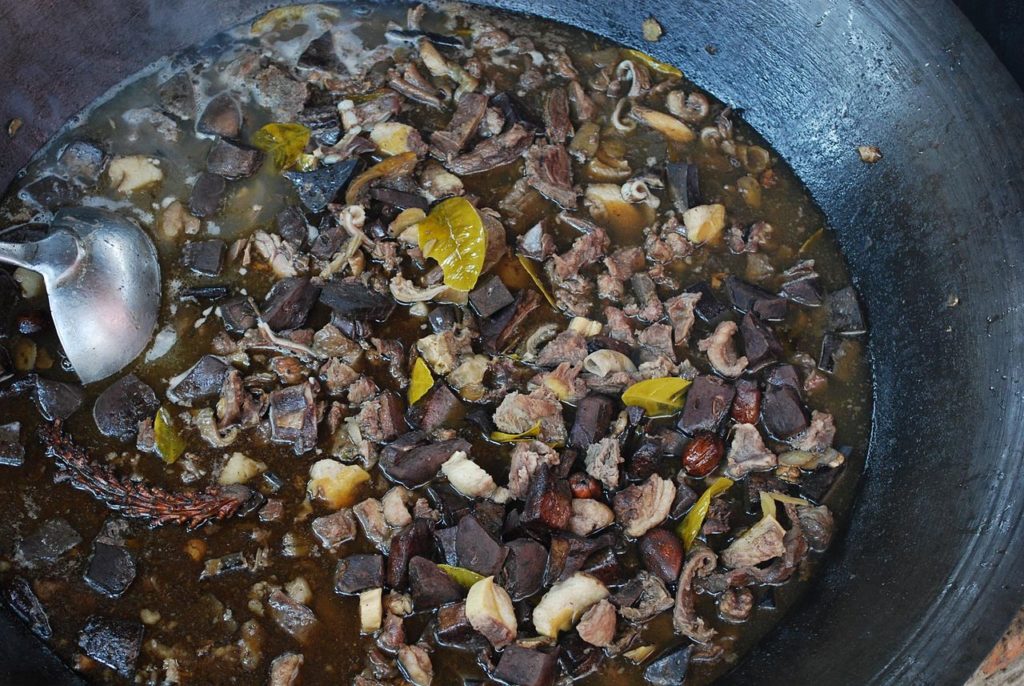For indigenous people around the world, food is a celebration of their deep-rooted relationship with traditional lands and their use, from highlands and tropical jungles to rivers and seas. In Southeast Asia, there are more than 350 ethnic groups, each with its own distinctive culinary traditions that mirror ancestral knowledge of native ingredients and time-treasured preparation techniques.
1. Linopot
Rice – the staple food of the indigenous Kadazan, Dusun, Murut and Rungus of Malaysia’s Sabah state- is celebrated in a dish called linopot. The dish consists of cooked hill paddy rice that’s mashed with root vegetables like cassava, yam or sweet potatoes, then wrapped in large wonihan (Macaranga bancana) leaves.
 This humble offering, which translates to “packing” in the Dusun language, is often accompanied by a slew of traditional sides like tuhau (wild ginger), hinava (raw fish salad), losun (wild spring onions) and fried salted fish.
This humble offering, which translates to “packing” in the Dusun language, is often accompanied by a slew of traditional sides like tuhau (wild ginger), hinava (raw fish salad), losun (wild spring onions) and fried salted fish.
Previously, farmers who toiled in the fields from sunrise to sundown would carry linopot with them for sustenance. Today, however, the dish is usually the highlight of the Kaamatan festive spread.
2. Umai
A dish of raw fish cured in the acidic juice of the sour asam payak fruit that grows in the swamps of Sarawak, Malaysia, umai is a staple of the coastal Melanau who live around the Rajang River.
 Traditionally made with sliced ikan popot (Chinese herring) or ikan pirang (hairfin anchovy), this no-cook dish was the go-to for fishermen looking for a quick and easy way to line their stomachs while out at sea.
Traditionally made with sliced ikan popot (Chinese herring) or ikan pirang (hairfin anchovy), this no-cook dish was the go-to for fishermen looking for a quick and easy way to line their stomachs while out at sea.
Over time, the dish made its way into Melanau kitchens where herbs like shallots, torch ginger and chillies were tossed into the mix, turning it into a refreshing, zingy salad to be enjoyed with another Melanau favourite – dried, crunchy sago pellets.
3. Saksang
The Batak Toba who inhabit the lush highlands surrounding Lake Toba in Indonesia’s North Sumatra are accustomed to using pork in their traditional fare.
One of their most treasured delicacies is saksang, a dish of pork cubes cooked in pig’s blood, along with aromatics like garlic, lemongrass, cinnamon, and andaliman – a local wild pepper that has a numbing effect similar to that of Sichuan peppercorns.
 Often served during cultural rituals, weddings and funerals, this thick, dark brown stew is sweet, savoury and spicy.
Often served during cultural rituals, weddings and funerals, this thick, dark brown stew is sweet, savoury and spicy.
Some variations of the dish use buffalo and dog meat, as well as coconut milk to add to its creaminess.
4. Sabuti
For Myanmar’s Chin people, nothing quite beats the meaty corn stew sabuti, especially on a chilly evening.
Its name – which can be broken down to sa for “meat”, bu for “boiled corn” and ti for “soup” – reflects the main components of this hearty dish.
The corn in the recipe refers to sweet, earthy and nutty hominy or dried corn kernels, which are stewed with cubes of pork and pork bones or beef offal to obtain a flavourful broth.
The dish is accompanied with slices of meat that are fried until crisp and dry like jerky, and a pungent condiment made from pounded garlic, stink beans, red or green chillies and celery leaves with a drizzle of fish sauce.
5. Thang co
For the Hmong people who live in the mountainous areas of northwestern Vietnam, horses are more than just a means of transportation – they are also a source of sustenance.
One of the most popular ways to enjoy horse meat is thang co, a spicy, aromatic stew that has been savoured for generations.
 To prepare this hearty dish, chunks of horse meat, bones and innards including the liver, heart and bowels are left to simmer for hours in a large pot over a wood fire.
To prepare this hearty dish, chunks of horse meat, bones and innards including the liver, heart and bowels are left to simmer for hours in a large pot over a wood fire.
To remove the meat’s gamey aroma, over 12 types of herbs and spices including lotus seeds, sagebrush, cardamom, star anise, gingery thao qua (Lanxangia tsaoko) and wolfberries are added to the piping hot mix.
6. Inandila
Inandila – short for sinandila or “just like a tongue” – is a popular glutinous rice dish served at birthdays, weddings, baptisms and housewarmings by the Kalinga of the Philippines’ Cordillera region.
 This dessert is made by pounding heirloom red sticky rice to form a rectangular cake, which is neatly wrapped in a banana leaf and boiled for over 30 minutes.
This dessert is made by pounding heirloom red sticky rice to form a rectangular cake, which is neatly wrapped in a banana leaf and boiled for over 30 minutes.
The chewy rice cake is then slathered in a sweet, buttery concoction called latik or coconut caramel, and topped with crushed nuts.
7. Sotong hitam
Centuries before they were resettled on Singapore’s mainland, the Orang Laut, Singapore’s first peoples, inhabited areas along the Kallang and Seletar rivers, as well as the smaller islands of Semaku and Seking.
The culinary heritage of these seafaring nomads reflects the abundance of their traditional lands, featuring fished and foraged foods from marine-rich waters and lush mangrove-lined rivers.
One of their most recognisable dishes is sotong hitam, a spicy and deeply savoury dish of squid cooked with a blend of dried chillies, garlic and onions, as well as generous splashes of its own ink.
According to airasia.com














